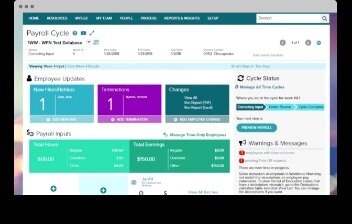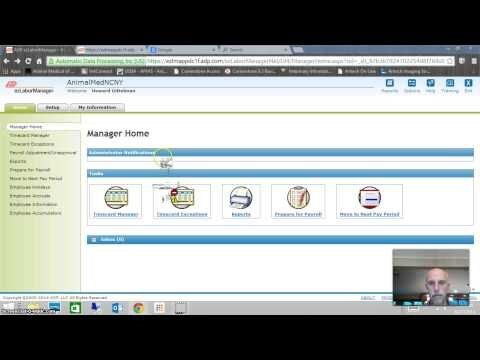Creating Reports Overview 2020

Content

This is ADP’s time management and attendance software. You can purchase it with your ADP software package. Employees can log in to the system and enter their timecard information, hours and any other relevant payroll information. This data is automatically uploaded to your paydata grid. You can get into the system and manually correct or adjust any data as needed. This process saves a lot of time and limits mistakes due to data entry errors. The system keeps salary and tax data for each employee and automatically calculates this information based on the number of hours you input.

If an employee attempts to record a punch outside the timeclock schedule restriction window associated with his or her timeclock restriction group, the punch will not be accepted. Includes only actual hours, scheduled hours, and any variance between the hours for each employee in the selected time frame. This is a streamlined version of the detail report.
The Reconciliation Report also indicates whether each adjustment has been accepted or rejected. Note that this button is approving the timesheet import, not approving payroll. You’ll be able to make edits to the timesheet data on the next page. Click on the “Search” button, and the paydata for this batch will be displayed. You can see complete payroll information for all of the employees in this batch. Click on the “Enter Paydata icon” and select “Paydata” from the popup menu. You will be directed to a window where you can create a payroll batch.
Select the employee or batch of employees and click “Go to Payroll Cycle.” You can now enter information such as the employees’ hours and any overtime, deductions and leave entitlements. This opens a Timeclock Restriction Group Lookup window that displays the timeclock restriction groups that have been defined for your company. Includes actual hours, scheduled hours, and any variance between the hours for each employee and each pay date in the selected time frame.
You enter paydata in batches, which are groups of employees. You can use previously-created batches, or you can create and customize new batches.Click on “Process” in the task bar at the top of the page. In the pop-up menu, under “Payroll,” select “Payroll Cycle.” You will be directed to the Payroll Cycle page. You can run timeclock reports to view which employees are assigned to which timeclocks, timeclock groups, and timeclock restriction groups. For instructions, see Using Timeclock Reports to View Timeclock Assignments. The lookup window closes and the description for each selected timeclock group is displayed in the Timeclock Groups Assigned field on the Employees page.
Small Business Employee Time Tracking
Our software also has geofencing features so you can ensure that employees using mobile devices are in the proximity of a pre-defined work location. At ADP, we realize that timekeeping is just one piece of the bigger HR picture, which is why our employee time tracking is part of the same system as our payroll and benefits administration. Information that’s updated in one place will update everywhere and your employees will only need one set of login credentials. Time and attendance features are part of all ADP HCM platforms. This means that users only need one username and password, the experience and design is consistent, and all pertinent information is housed in a centralized location. Employee data flows automatically between HR, payroll and timekeeping so there is no re-keying, fewer mistakes and more timely access to data. The Reconciliation Report provides a complete itemized list of the discrepancies found between employees’ projected and actual hours and rates per earnings code.
With cloud-based time and attendance software, a smart time clock records the information, calculates the total hours immediately and sends them to payroll automatically. ADP time clocks also offer biometric identification, which prevents employees from clocking in or out for each other, also known as “buddy punching.” Flexible access to information helps remove obstacles, creates a seamless experience and improves the overall engagement of your workforce. Designed with self-service options, ADP’s time and attendance solutions works with smart time clocks, web browsers and mobile devices. This allows authorized employees and supervisors to complete time-sensitive tasks quickly, easily and in a way that works best for them. When you use ADP’s time and attendance solutions, staff enter their hours worked using a smart time clock, a web timesheet or a clocking app available on a mobile device.
A count of employees who meet or exceed the total paid hours threshold is also included. Click the button to open a lookup window and select one or more items to add to the values already displayed in the Selected Values box.
- ADP Time and Attendance allows you to merge your reports with any major payroll processing service, or you can use them to run payroll yourself.
- Once you’ve collected your employees’ hours for the pay period, it’s time to run payroll.
- To use ADP for payroll, start by making a new payroll cycle to clear out any old data.
- Once the popup window closes and the new payroll cycle page returns, you can set up the employees who are to be paid by clicking on “Process” in the task bar.
- And of course, no time and attendance system integrates with ADP’s own payroll service better than ADP Time and Attendance.
Also, employees set up for Automatic Pay automatically receive a paycheck. However, sometimes you need to make one-time changes. Input the appropriate salary information in the paydata grid.
Tipped Employees
Timeclock groups allow you to assign employees to multiple timeclocks in one step. Ensure greater consistency with calculation and distribution of hours. When time is recorded electronically by the employee it can reduce data entry errors and flow easily to payroll. Actual and projected hours for each week in the month for the selected time frame, the total paid hours per month, and the average weekly and monthly totals.
If any timeclock groups have been created for your company and you want to assign the employee to a timeclock group, click the button in the Timeclock Groups Assigned section. This opens a Timeclock Group Lookup window that displays the timeclock groups that have been defined for your company. If timeclock restriction groups have been created for your company, you can assign individual employees to these groups, one employee at a time. You can also request that an ADP Time & Attendance Representative assign an entire pay group to a timeclock restriction group. An employee can only be assigned to one timeclock restriction group. If your company wants to restrict when employees can use timeclocks, an ADP Time & Attendance Representative can create timeclock restriction groups for you.
The lookup window closes and the description for each selected timeclock is displayed in the Timeclocks Assigned field on the Employees page. If your company uses multiple timeclocks and you want individual employees to be able to use more than one timeclock, you can create timeclock groups to make managing timeclock assignments easier.
This will override the Automatic Pay for the employee for this pay period. Hours.” Enter the number of regular hours each employee worked. The system will automatically calculate the gross salary, deductions and net salary for the pay period. Click on the “save” button frequently to save data you have entered. When you are done, click on the “done” button.Enter the number of overtime hours in the “O/T Earnings” column. This is the process for entering data for your salaried and hourly employees who are not set up for Automatic Pay.
They also have timely visibility into who may be approaching overtime so they can adjust schedules accordingly. ADP time and attendance solutions make it easier and faster to create schedules that work for everyone. You can spot trends and correct gaps in coverage before they negatively impact your environment and employees have access to self-service features for improved productivity and engagement. This step allows you to verify the accuracy of the payroll once it’s been calculated. In the Payroll Cycle window, click on the “Preview Results” icon.
How Much Paid Time Off Are Employees Entitled To?
This version of the report can also include optional payroll information that allows you to see how time is distributed to payroll. For additional information, see Actual vs. Scheduled Hours Report. While time clocks are certainly better than handwritten or paper timesheets, they typically only record punches or timestamps. Someone still needs to calculate the hours worked, know how to apply the pay rules and enter the time into payroll.
The system then automatically calculates the totals and sends them to payroll, leaving you and your managers with just exception and approval tasks. As a result, you have more time to spend improving business operations and supporting customers. Your company may employ salaried employees or hourly employees who work a fixed number of hours each pay period. Work with an ADP representative to set up Automatic Pay for these employees. This way, you won’t have to enter their pay data each pay period.You can make changes to an employee’s salary or number of hours any time you need to. Click the timeclock restriction group to which you want to assign the employee. The lookup window closes and the selected group is entered in the Timeclock Restriction Group field on the Employees page.
Use the button to remove items from the list in the Selected Values box. How can I monitor my employees’ hours with ADP’s employee time tracking? Designed to make work more open and flexible, ADP’s employee time tracking captures hours at the source and processes time worked and time off based on your company rules and policies. Security features, such as biometric identification, help ensure integrity of the timecard data.
Workers enter their time online and the time and attendance softwaretakes care of the rest. It calculates hours from the punches and automatically flows the data to payroll, saving time and reducing errors.
They can also help payroll professionals stand out as people that employees, managers and department heads trust to get their pay checks right. The Timeclock Restriction Group field will only be visible if timeclock restriction groups have been created for your company.

Yes, complying with the Fair Labor Standards Act and controlling overtime costs are two of the biggest benefits of online time and attendance solutions. Employee time trackingstarts with proper classification of workers, followed by automatic and accurate calculation of hours worked during the pay period. Overtime rules specific to individual businesses and locations are then applied and sent for payroll processing. Managers only need to approve timecards, not calculate hours or apply overtime rules.
If your business has more than one company that processes payroll, confirm the correct company code. To change the company code, click on the magnifying glass icon and select the correct company code.If you don’t have more than one company, do nothing. There are many different payroll software companies you can use to process payroll but ADP does an exceptional job at helping your company process payroll. ADP can help payroll professionals grow along with company changes.
You can review total payroll information for the entire company. Also, you can drill down to verify payroll information by department or for individual employees.If you find incorrect information, click “Make Corrections” and edit the payroll batch. Then you will have to go back to the previous step and recalculate the payroll, and then run “Preview Results” function to verify the payroll once more.
Employee Time Tracking That Can Help Save Money And Improve Productivity
Once you’ve collected your employees’ hours for the pay period, it’s time to run payroll. ADP Time and Attendance allows you to merge your reports with any major payroll processing service, or you can use them to run payroll yourself. And of course, no time and attendance system integrates with ADP’s own payroll service better than ADP Time and Attendance. To use ADP for payroll, start by making a new payroll cycle to clear out any old data. Once the popup window closes and the new payroll cycle page returns, you can set up the employees who are to be paid by clicking on “Process” in the task bar. Then click “Enter Paydata” and select “Paydata” from the popup menu.
The report also lists the adjustments necessary to reconcile each employee’s received pay with his/her actual worked hours. These automatically generated adjustments are not posted to employee’s records until a practitioner approves them.



